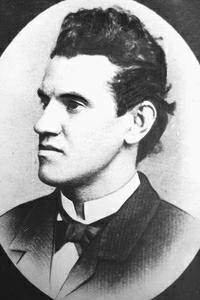<Back to Index>
- Physicist Joseph Antoine Ferdinand Plateau, 1801
- Composer Ciprian Porumbescu, 1853
- 1st Taoiseach of Ireland Éamon de Valera, 1882
PAGE SPONSOR

Ciprian Porumbescu (born Cyprian Gołęmbiowski on October 14, 1853 – June 6, 1883) was a Romanian composer born in Şipotele Sucevei in Bukovina (now Shepit, Putyla Raion, Ukraine). He was among the most celebrated Romanian composers of his time; his popular works include Crai nou, Trei culori, Song for the 1st of May, Ballad for violin and piano, and Serenada. In addition, he composed the music for Pe-al nostru steag e scris Unire, which was used for Albania's national anthem, Hymni i Flamurit. His work spreads over various forms and musical genres, but the majority of his work is choral and operetta.
Ciprian Porumbescu was born into the family of Iraclie Gołęmbiowski (who changed the Polish sounding family name to its Romanian translation), an ethnic Romanian writer and Orthodox priest of possible Polish origins. He studied music in Suceava and Cernăuţi, then continued at the Konservatorium für Musik und darstellende Kunst in Vienna from 1879 to 1881 under Anton Bruckner and Franz Krenn. His artistic career as a composer, conductor, violinist, and pianist started in Cernăuţi, and continued in Vienna, and later in Braşov where he taught vocal music at Romanian schools.
Ciprian Porumbescu wrote poetry, lyrics and press articles, and actively participated in the public cultural life. He helped the rise of the Romanian music school during an age of enthusiasm generated by Romania's independence. Some of the most remarkable musical pages of the composer were inspired by national heroes and great army leaders, such as Stephen III of Moldavia and Dragoş Vodă. The appreciation of his music came from the melodic nature of his compositions and their folklore inspiration.
Ciprian Porumbescu left a legacy of more than 250 works, bringing him fame and popularity through his short life. The composer saw his work Crai Nou (New Moon) performed in Braşov, while his vocal works Pe-al nostru steag (On our flag), Treiculorul (Three coloured), Cântec de primăvară (Spring song), Serenada, Cântecul gintei latine (Latin nation song), La malurile Prutului (On the Prut's shores), and Altarul manastirii Putna (Putna monastery's altar) were already in the public conscience. He died at the age of 29 in Stupca, which was renamed Ciprian Porumbescu in his honor.
As a student at the Vienna Musical Conservatory, Porumbescu noted with great interest the success of operettas by Strauss, Suppé, Offenbach and others. His supreme goal was to replace the frivolity of subject matter in the fashionable operettas with a plot that revived old Romanian traditions. Among them was Crai Nou (New Moon), in which the new-born moon will fulfill every lover's dreams of happiness (collected and published by Vasile Alecsandri), appeared the most appropriate for the dream-like environment of the local and earnest task he had in mind. The result was Romania's first operetta of the same name.
Finished on October 21, 1880, the Ballad for Violin and Orchestra soon became the best known work by Ciprian Porumbescu, and a reference work in Romanian classical music of the 19th century. In seclusion at Stupca, the composer meditated, drafted and then finished the piece, full of poetry and bitter nostalgia, with light and shade, a mixture of "doina", old dance and song, everything in the environment of serene melancholy.
The Romanian Rhapsody for piano was composed before Ciprian Porumbescu left for Vienna, and the orchestral version was performed for the first time in Braşov on 15 October 1882, with the composer conducting at a concert devoted to his music. The audience was deeply impressed, while the local press of the time wrote about it with enthusiasm, pathos and patriotic pride.